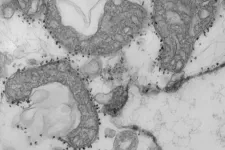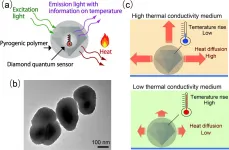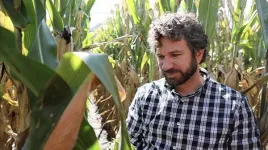New study connects religiosity in US South Asians to cardiovascular disease
Scientific Reports publishes the first study to analyze the relationships among proteomic signatures, religion and spirituality and risk of developing a clinical condition
2021-01-16
(Press-News.org) BOSTON - The Study on Stress, Spirituality and Health (SSSH), a cutting-edge proteomics analysis, suggests that religious beliefs modulate protein expression associated with cardiovascular disease in South Asians in the United States. The research, published by investigators from Massachusetts General Hospital (MGH) and Beth Israel Deaconess Medical Center (BIDMC) and the University of California San Francisco (UCSF) in Scientific Reports, demonstrates that spiritual struggles, in particular, significantly modify the impact of unique proteins on risk of developing cardiovascular disease (CVD) in U.S. South Asians, a community that has especially high rates of CVD.
This study represents the first proteomics analysis ever conducted on protein levels in relationship to CVD within a U.S. South Asian population and the first published study to analyze proteomics signatures in relationship to religion and spirituality in any population.
"Before we can develop the best interventions to reduce CVD disparities, we need to understand the biological pathways through which health disparities are produced," says the study's principal investigator and co-senior author Alexandra Shields, PhD, director of the Harvard/MGH Center on Genomics, Vulnerable Populations and Health Disparities at the MGH Mongan Institute and associate professor of Medicine at Harvard Medical School (HMS). "As this study shows, psychosocial factors - and religious or spiritual struggles in particular - can affect biological processes that lead to CVD in this high-risk population. Spirituality can also serve as a resource for resilience and have a protective effect. Given that many of the minority communities that experience higher levels of CVD also report higher levels of religiosity and spirituality, studies such as the SSSH may help identify new leverage points, such as spiritually focused psychotherapy for those in spiritual distress, that could reduce risk of CVD for such individuals."
Results of the study, which included 50 participants who developed CVD and 50 sex- and age-matched controls without CVD from the Mediators of Atherosclerosis in South Asians Living in America (MASALA) Study (100 participants), indicate that there may be unique protein expression profiles associated with CVD in U.S. South Asian populations, and that these associations may also be impacted by religious struggles, in which, for example, individuals experiencing adverse life events feel they are being punished or abandoned by their God, or have a crisis of faith. The MASALA study includes 1,164 South Asians who were recruited from the San Francisco Bay Area and the greater Chicago area and followed for approximately eight years with the goal of investigating factors that lead to heart disease among this high-risk ethnic group. MASALA is one of the original cohorts participating in SSSH, through which this research was conducted.
"Understanding the pathways of this mechanism at the molecular level using proteomics technology is crucial to developing potential interventions that can help reduce CVD incidence in this population," says Long H. Ngo, PhD, lead author and co-director of Biostatistics in the Division of General Medicine at BIDMC and associate professor of Medicine at HMS.
Co-senior author Towia Libermann, PhD, director of Genomics, Proteomics, Bioinformatics and Systems Biology Center at BIDMC, adds: "The kinds of blood-based protein biomarkers used in this study are particularly effective in assessing CVD risk because they carry clinical information about risk of disease and are the most commonly used molecules for diagnostic applications."
INFORMATION:
Other investigators included Alka Kanaya, MD, professor of Medicine at UCSF and principal investigator of the MASALA Study; Austin Argentieri, MPhil, research associate at the Harvard/MGH Center on Genomics, Vulnerable Populations, and Health Disparities; and Blake Victor Kent, assistant professor of Sociology at Westmont College, Santa Barbara, California.
The research was funded by a grant from the John Templeton Foundation.
About the Massachusetts General Hospital
Massachusetts General Hospital, founded in 1811, is the original and largest teaching hospital of Harvard Medical School. The Mass General Research Institute conducts the largest hospital-based research program in the nation, with annual research operations of more than $1 billion and comprises more than 9,500 researchers working across more than 30 institutes, centers and departments. In August 2020, Mass General was named #6 in the U.S. News & World Report list of "America's Best Hospitals."
ELSE PRESS RELEASES FROM THIS DATE:
2021-01-16
One of the most vexing aspects of the COVID-19 pandemic is doctors' inability to predict which newly hospitalized patients will go on to develop severe disease, including complications that require the insertion of a breathing tube, kidney dialysis or other intensive care. Knowledge of a patient's age and underlying medical conditions can help predict such outcomes, but there are still surprises when younger, seemingly healthier patients suffer severe complications that can lead to death.
Now, scientists at Washington University School of Medicine in St. Louis have shown that a relatively simple and rapid blood test can predict -- within a day of a hospital admission -- which patients with ...
2021-01-15
MIAMI--A group of more than 60 scientists have provided recommendations to improve the Indian Ocean Observing System (IndOOS), a basin-wide monitoring system to better understand the impacts of human-caused climate change in a region that has been warming faster than any other ocean.
The group, led by Lisa Beal, professor of ocean sciences at the University of Miami (UM) Rosenstiel School of Marine and Atmospheric Science, provides a road map for an enhanced IndOOS to better meet the scientific and societal needs for more reliable environmental forecasts in the next decade. The 136 actionable recommendations from the three-year, internationally coordinated review were published in the Bulletin of the American Meteorological Society.
The scientists call for four major ...
2021-01-15
A University of Saskatchewan study has found that the COVID-19 pandemic has led to significant worsening of already poor dietary habits, low activity levels, sedentary behaviour, and high alcohol consumption among university students.
The findings of the study--the first to assess changes in students' dietary intake, physical activity, and sedentary behaviour before and during the pandemic--are published today in the journal Applied Physiology, Nutrition and Metabolism.
"Our findings are important because university students, especially those most vulnerable for poor nutrition and sedentary behaviour, should be targeted for interventions aimed at maintaining and improving physical activity and dietary practices during this pandemic and beyond," said lead author ...
2021-01-15
As the vaccination of older adults against COVID-19 begins across the country, new poll data suggests that many of them don't yet have access to the "patient portal" online systems that could make it much easier for them to schedule a vaccination appointment.
The poll finds that 45% of adults aged 65 to 80, and 42% of all adults aged 50 to 80, said they had not set up an account with their health provider's portal system. That's according to the newly analyzed data from the National Poll on Healthy Aging, based at the University of Michigan's Institute for Healthcare Policy and Innovation.
The new number actually represents some progress: 49% of adults in the same age range hadn't set up patient portal access the last time the ...
2021-01-15
Exactly what kills a person with COVID-19?
How do those deaths differ from the deaths of people whose lungs fail rapidly because of other infections or injuries?
And what can hospital teams pressed into service on overtaxed COVID-19 wards do to try to keep patients from dying, despite strained circumstances?
All of these questions have sparked discussion - and even conspiracy theories - since the pandemic began. Now, two studies from Michigan Medicine may help answer them.
The bottom line: COVID-19 deaths are indeed different from other lung failure deaths. But, the researchers conclude, the kind of care needed to help sustain people through the worst cases of all forms of lung failure is highly similar. It just needs to be fine-tuned to focus on the ...
2021-01-15
Scientists have uncovered new clues implicating a type of herpes virus as the cause of a central nervous system disease in monkeys that's similar to multiple sclerosis in people.
The findings, published in the Annals of Clinical and Translational Neurology, expand on previous work to understand the cause of the disease and potentially develop antiviral therapies. The work was led by scientists at Oregon Health & Science University.
"This gives us a better understanding of the model," said Scott Wong, Ph.D., senior author of the study and a scientist at the OHSU Vaccine and Gene Therapy Institute and the Oregon National Primate Research Center. "It draws more parallels to MS in people."
The new study reveals the presence of two kinds of T cells, a type of ...
2021-01-15
In groundbreaking materials research, a team led by University of Minnesota Professor K. Andre Mkhoyan has made a discovery that blends the best of two sought-after qualities for touchscreens and smart windows--transparency and conductivity.
The researchers are the first to observe metallic lines in a perovskite crystal. Perovskites abound in the Earth's center, and barium stannate (BaSnO3) is one such crystal. However, it has not been studied extensively for metallic properties because of the prevalence of more conductive materials on the planet like metals or semiconductors. The ...
2021-01-15
Osaka, Japan - A team of scientists from Osaka University, The University of Queensland, and the National University of Singapore's Faculty of Engineering used tiny nanodiamonds coated with a heat-releasing polymer to probe the thermal properties of cells. When irradiated with light from a laser, the sensors acted both as heaters and thermometers, allowing the thermal conductivity of the interior of a cell to be calculated. This work may lead to a new set of heat-based treatments for killing bacteria or cancer cells.
Even though the cell is the fundamental unit of all living organisms, some physical properties have remained difficult to study in vivo. For example, a cell's thermal conductivity, as well as the rate that heat can flow through an object if ...
2021-01-15
Berkeley -- Most frogs emit a characteristic croak to attract the attention of a potential mate. But a few frog species that call near loud streams -- where the noise may obscure those crucial love songs -- add to their calls by visually showing off with the flap of a hand, a wave of a foot or a bob of the head. Frogs who "dance" near rushing streams have been documented in the rainforests of India, Borneo, Brazil and, now, Ecuador.
Conservation ecologist Rebecca Brunner, a Ph.D. candidate at the University of California, Berkeley, has discovered that the glass frog ...
2021-01-15
Plant pathologists working at universities across 26 corn-producing states in the United States and in Ontario, Canada, compiled data about annual corn reductions caused by diseases. Estimated loss from each disease varied greatly by region.
"This group of plant pathologists takes a step back to estimate what has gone wrong in corn fields in each of their states," said Iowa State University plant pathologist Daren Mueller, who was involved in this project. "Collectively, and across years, corn disease loss estimates provide folks a zoomed out view of what diseases are affecting corn in the U.S. and Canada."
To Mueller, these data represent one of the pieces of a good research project. Researchers can use these data to justify new research projects that can help mitigate the impacts ...
LAST 30 PRESS RELEASES:
[Press-News.org] New study connects religiosity in US South Asians to cardiovascular disease
Scientific Reports publishes the first study to analyze the relationships among proteomic signatures, religion and spirituality and risk of developing a clinical condition




